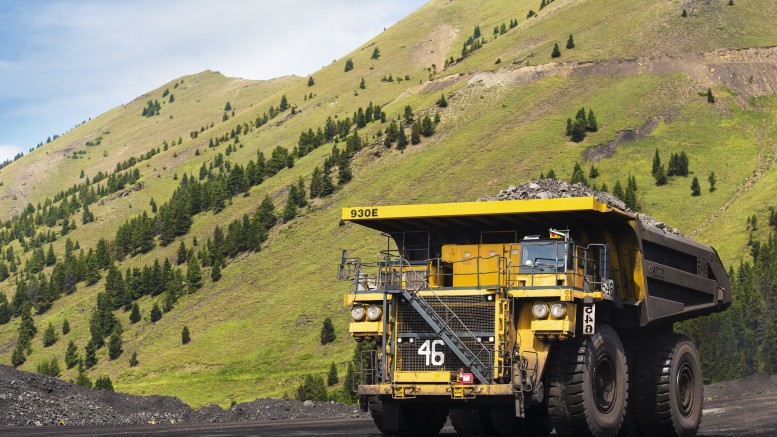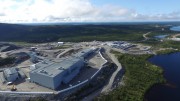To get a pulse on the health of Canada’s mining industry, it’s useful to browse through the newly released Mining Sector Performance Report 2006–2015, which is prepared by the Intergovernmental Working Group on the Mineral Industry for submission to the Energy and Mines Ministers’ Conference held in Winnipeg in August 2016.
The report is only prepared once every three years, with the assistance of a variety of external stakeholders, and it is presented to Canada’s federal, provincial and territorial mines ministers. The report provides an overview of global mining trends, and assesses the mining sector’s economic, social and environmental performance within Canada.

Canadian global production ranking in 2015, by volume. Credit: Mining Sector Performance Report 2006-2015, using data from Natural Resources Canada and U.S. Geological Survey.
Above all, the report emphasizes that Canada remains one of the world’s leading mining nations — producing more than60 minerals and metals — and ranks as a global leader in commodities such as potash, uranium, gold, primary aluminum, nickel and diamonds. There are now more than 200 principal producing mines and 50 smelters, refineries and steel mills in Canada.
The report authors expect the global economic recovery — and by extension, the demand for mineral commodities — to “strengthen towards the end of 2017 and beyond, as the result of a gradual normalization of conditions in a number of the stressed economies, the rebalancing of China’s economy and a pickup in commodity export activity.”
Government big-picture data can often be slow in coming out, so this report gives a first glimpse at many of the macro-economic numbers for mining in Canada in 2015.
Strikingly, because the prices of most major mineral commodities have fallen since 2011, this has resulted in the nearly 40% drop in the Bank of Canada’s Metals & Minerals Commodity Price Index in 2015. This has translated into capital investment activity in Canada’s mining industry dropping 35% in 2015, compared to 2012 levels, with more declines expected in 2016.
Even with the global economic downturn, Canada’s mineral industry posted impressive numbers for 2015. The report found mining in Canada accounted for $60.2 billion in nominal gross domestic product (or 3.2% of total Canadian GDP), with $27.9 billion in mineral extraction and mining-related support activities, and $32.3 billion in downstream mineral processing and manufacturing. The mining industry directly employed 373,000 workers in Canada in 2015 (10,300 of whom were indigenous people), including mining-related support activities, with a presence in every region of the country.
Furthermore, mining contributed $16.2 billion to Canada’s trade balance in 2015, including $92 billion in merchandise exports (or 19.1% of total exports), and has contributed $172 million to Canada’s balance of trade since 2006.
The value of mineral production Canada-wide in 2015 totalled $42.8 billion (not including oilsands), with the following breakdown by province and territory, including each jurisdiction’s top-two products: Ontario, $10.8 billion, gold & nickel; Saskatchewan, $8.5 billion, potash & uranium; Quebec, $7.7 billion, gold & iron ore; British Columbia, $5.9 billion, copper & coal; Newfoundland and Labrador, $2.8 billion, iron ore & nickel; Alberta, $2.5 billion, sand and gravel & coal; Northwest Territories, $1.8 billion, diamonds & tungsten; Manitoba, $1.4 billion, nickel & copper; Nunavut, $0.6 billion, gold & silver; New Brunswick, $0.4 billion, potash & peat; Yukon, $0.2 billion, gold & copper; Nova Scotia, $0.2 billion, stone & salt; and Prince Edward Island, $4.6 million, peat & sand and gravel.

Value of Canadian mineral production 2006-15. Credit: Mining Sector Performance Report 2006–2015.
Meanwhile, expenses on mineral exploration and deposit appraisal totalled $1.7 billion Canada-wide during 2015, with the following breakdown: Ontario, $393 million; British Columbia, $331 million; Saskatchewan, $258 million; Quebec, $220 million; Nunavut, $215 million; Northwest Territories, $100 million; Yukon, $73 million; Newfoundland and Labrador, $48 million; Alberta, $17 million; Nova Scotia, $10 million; New Brunswick, $8 million; and Prince Edward Island, zero.

Canadian exploration and deposit appraisal expenditures by province and territory: 2006, 2011, and 2015. Credit: Mining Sector Performance Report 2006-2015, from Natural Resources Canada data, with 2015 data being preliminary (p).
As of 2014, Canadian mineral exploration and mining assets abroad were worth $169.7 billion, and were located in more than 100 countries.




Be the first to comment on "Editorial: Canada’s mining industry still a powerhouse"